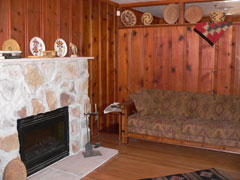Story and photos by Miriam Raftery
 |
| Olaf Wieghorst historic home |
March 11, 2009 (El Cajon) — Recently designated a historic site by the City of El Cajon, the long-time home of famed western artist Olaf Wieghorst will open to the public on Thursday, March 19th at 4 p.m. In an exclusive interview with East County Magazine, the artist's son, Roy Wieghorst, shares his memories of his famous father and his boyhood home.
 |
| Navajo Madonna |
"We came out here in 1944," Roy Wieghorst recalled, stepping inside the modest wooden house with warm knotty pine interiors, simple furnishings and a replica of the easel where his father painted many of his most well-known works. "My father used to wipe his brushes on the wall," Wieghorst recalled, pointing out splotches of paint still visible today. "The place seemed a lot bigger back then. This is the house that my family and I lived in when I was a teenager."
 Originally located a the intersection of Sunshine and Renette, the house was recently moved to a lot adjacent to the Olaf Wieghorst Museum and Western Heritage Center at 131 Rea Street in El Cajon.
Originally located a the intersection of Sunshine and Renette, the house was recently moved to a lot adjacent to the Olaf Wieghorst Museum and Western Heritage Center at 131 Rea Street in El Cajon.
Now located next to the Olaf Wieghorst Museum and Western Heritage Center at 131 Rea Street in El Cajon, the home has been moved from its original location at the intersection of Sunshine and Renette Street. In 1956, the City of El Cajon annexed the original home site. Since horses were prohibited within City limits, the Wieghorst family moved to a more rural area in the outskirts.
 |
| Roy Wieghorst and his famous father's trick saddle |
"My father continue to paint for his entire life. He loved painting--and he loved horses," Wieghorst's son recalled. "He was in two movies with John Wayne, who was a good friend." The artist even had a bit part as a gunsmith in the movie El Dorado, starring John Wayne, and appeared in the film McLintock as well. The opening credits of El Dorado are shown over a background of Wieghorst's paintings.
 |
| Replica easel and original paint brush strokes on wall inside Wieghorst historic home |
"Four presidents bought his paintings," Roy Wieghorst said. "Eisenhower had one over his desk in the oval office."
Born in Denmark in 1899, Olaf Wieghorst sailed to America as a cabin boy aboard a steamer to pursue his dream of seeing the rugged country he knew only from books and museums. He served in the U.S. Cavalry and later, in the mounted division of the New York Police Department. But his interludes as a wrangler on Western ranches provided inspiration for the images of majestic landscapes and legendary individuals who lived and worked on the land that he later immortalized in his art. After retiring from the NYPD, he moved west with his wife, Mae, and their son, Roy.
In 1951, he hung his first "Adobe Wall Art Exhibit" on the patio in front of his home. After running an ad in the newspaper and inviting friends, he spread blankets over hay bales for seating, hired guitarists and a trick roper to entertain. Paintings were hung on the interior of an adobe-walled courtyard. Wieghorst received praise from critics and soon gained esteem as one of the finest western artists in America.
 |
| Living room/studio in Wieghorst home |
If you visit the historic home, be sure to stop in the Olaf Wieghorst Museum Foundation next door, where you can view original Wieghorst paintings and memorabilia. You can also purchase artworks in the museum gift store, such as prints of Wieghorst's famed Navajo Madonna painting (photo, right) as well as statues and paintings by contemporary western artists.
"This was my Dad's trick riding saddle," Roy Wieghorst noted, running his hands across the well-worn leather inside the museum. (photo) Pointing to a painting of a boy on horseback, he added, "This was a picture of me. I used to trick rope a lot."
Olaf Wieghorst died in 1988. Since then, some of his works have sold for over $1 million. Today, his works hang in numerous museums as well as private collections owned by Hollywood celebrities, arts patrons, industrialists, investors, presidents, and local residents.
The Olaf Wieghorst Foundation hopes to acquire additional properties to hosue the Western Heritage Center research library and collections. In addition, the Foundation aims to recreate an adobe stable and cantina that were integral to the original home site, ultimately making the facility available for art shows, exhibits, receptions, and community events.
For more information, visit www.wieghorstmuseum.org and www.olafwieghorst.com.







Recent comments